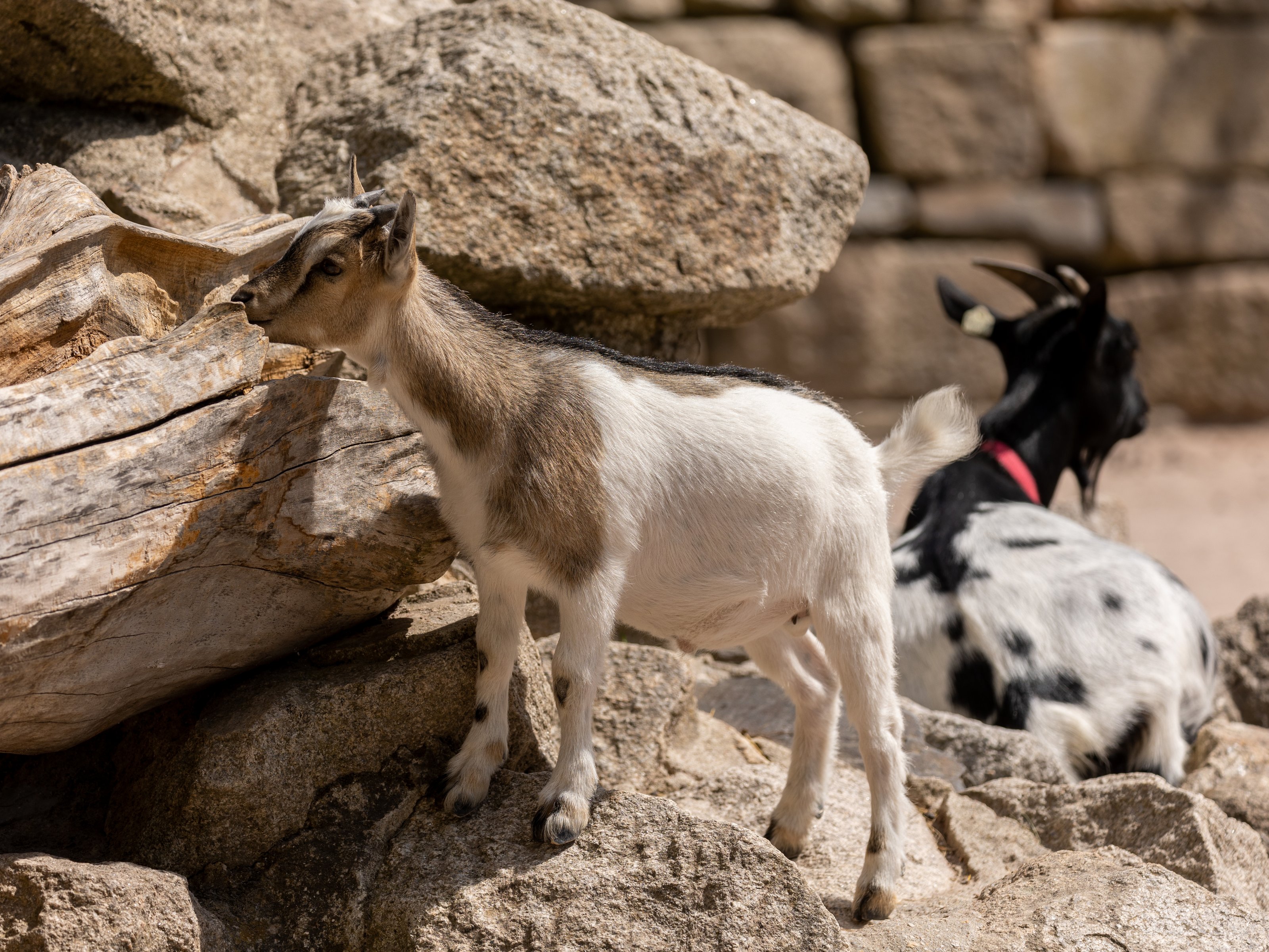
Station 18 Westafrikanische Zwergziege
Meckern erlaubt. Vor allem wenn etliche Jungtiere das Gehege bevölkern, wird verstärkt gemeckert. Aber dann liegen auch viele schwarze kleine Kugeln im ganzen Gehege verteilt, auch wenn kurz vorher der Besen seine Schuldigkeit getan hat.
Ziegen in allen möglichen Rassen werden fast auf der ganzen Welt gehalten. Sei es zur Milchgewinnung, zur Fleischnutzung oder als lebendiger Rasenmäher. Auch wurde hierzulande früher die Ziege als die Kuh des kleinen Mannes bezeichnet, da die zu gewinnenden Erträge recht klein waren. Dafür sind manche Ziegenrassen recht anspruchslos, finden überall Futter und brauchen keine großen Ställe. Oftmals bringen Ziegen zweimal im Jahr Junge zur Welt, nach einer Tragzeit von ca. 5 Monaten.
Gerne wird das Ziegengehege als Kontakt oder Streichelgehege genutzt, vor allem lieben es die Kinder, die Tiere zu streicheln oder zu bürsten. Manchmal gibt es aber auch Tränen, wenn doch mal eine Ziege stößt oder der Bock zu drängelig wird. So gibt es also auch immer ein Restrisiko beim direkten Kontakt mit lebenden Tieren. Da sollten die begleitenden Erwachsenen statt auf das Handy doch lieber ihre Kinder und die Tiere im Auge behalten.
Der Tiergarten wünscht allen ein schönes Erlebnis mit den Tieren und hofft, dass nur die Ziegen was zu meckern haben.
Station 18 Kozy
Mečení povoleno. Zvláště když je ve výběhu hodně mladých zvířat, se intenzita mečení zvyšuje. Ale pak je také po celém výběhu roztroušeno mnoho černých kuliček, i když koště krátce předtím vykonalo svou povinnost.
Kozy všech možných plemen se chovají téměř po celém světě. Ať už na produkci mléka, masa nebo jako živá sekačka na trávu. V této zemi se kozám říkalo krávy nižší třídy, protože výnosy, které se z nich získávaly, byly poměrně malé. Na druhou stranu jsou některá plemena koz poměrně nenáročná, potravu najdou všude a nepotřebují velké stáje. Kozy rodí často dvakrát ročně po přibližně pětiměsíční březosti.
Lidé rádi využívají kozí výběh ke kontaktu či mazlení; zejména děti rády kozy hladí nebo kartáčují. Někdy však dojde k slzám, když koza trkne nebo je příliš dotěrná. Při přímém kontaktu s živými zvířaty tedy vždy existuje jakési malé riziko. Dospělí, kteří děti doprovázejí, by tedy místo koukání do mobilu měli dávat pozor na své děti a zvířata.
Zoologická zahrada přeje všem krásné zážitky se zvířaty a doufá, že jen kozy mají důvod mečet.
Station 18 Goats
Bleating is allowed. Especially when several young animals populate the enclosure, there is increased bleating. But then there are also many black little balls scattered all over the enclosure, even if the broom has done its duty shortly before.
Goats in all possible breeds are kept almost all over the world. Be it for milk production, meat use or as a living lawn mower. Also, in this country, the goat used to be called the cow of the little man, because the yields to be obtained were quite small. On the other hand, some goat breeds are quite undemanding, find food everywhere and do not need large stables. Often goats give birth twice a year, after a gestation period of about 5 months.
The goat enclosure is gladly used as a contact or petting enclosure, especially children love to pet or brush the animals. Sometimes there are tears, however, when a goat bumps or the ram gets too pushy. So, there is always a residual risk in direct contact with live animals. Instead of looking at their cell phones, the accompanying adults should keep an eye on their children and the animals.
The zoo wishes everyone a wonderful experience with the animals and hopes that only the goats have something to complain about.